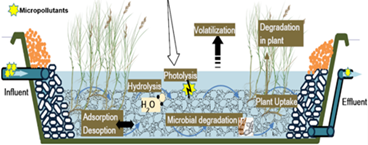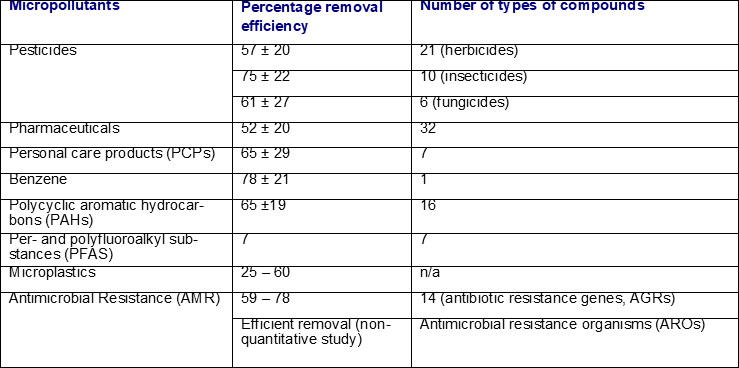Constructed wetlands, micropollutants and climate change
Jo Wybrow
The Environment Agency
[email protected]
Tao Lyu, Gabriela Dotro, Bruce Jefferson
Cranfield University
[email protected]
ECG Bulletin July 2022
The Environment Agency
[email protected]
Tao Lyu, Gabriela Dotro, Bruce Jefferson
Cranfield University
[email protected]
ECG Bulletin July 2022
Integrated Constructed Wetlands (ICWs), also known as ‘surface flow treatment wetlands’, have been applied worldwide to treat wastewaters and, as a nature-based solution, deliver other environmental benefits. Through its Chemicals Programme, the UK Environment Agency identifies key evidence gaps, commissions research, and improves understanding of chemical and climate risks. Hence actions can be implemented to reduce environmental impacts. We recently commissioned a project to summarise and consolidate our knowledge on ICWs.
Treatment wetlands (TWs) are artificially created systems designed to optimise processes occurring in natural wetlands and are, therefore, considered an environmentally friendly and sustainable option for wastewater treatment. Integrated constructed wetlands (ICWs) are surface-flow TWs that look like natural, open-water wetlands and mainly remove nutrients, nitrogen and phosphorus (1). In response to increased awareness of micropollutants, ICWs qualify as a potential solution to treat micropollutants and other emerging contaminants (e.g. microplastics, antimicrobial resistance). However, climate change poses a threat to both natural and constructed wetlands. Altered hydrology and rising temperatures can change the wetland’s biogeochemistry and function, thus compromising the performance of important services.
The Environment Agency commissioned this work to develop a concise literature review to summarise current evidence for treating sewage in ICWs beyond nutrient removal. The review covers 1) the removal of priority substances, for which environmental quality standards (EQS) exist, and other unregulated micropollutants; and 2) the interaction of climate change and ICW functions.
Treatment wetlands (TWs) are artificially created systems designed to optimise processes occurring in natural wetlands and are, therefore, considered an environmentally friendly and sustainable option for wastewater treatment. Integrated constructed wetlands (ICWs) are surface-flow TWs that look like natural, open-water wetlands and mainly remove nutrients, nitrogen and phosphorus (1). In response to increased awareness of micropollutants, ICWs qualify as a potential solution to treat micropollutants and other emerging contaminants (e.g. microplastics, antimicrobial resistance). However, climate change poses a threat to both natural and constructed wetlands. Altered hydrology and rising temperatures can change the wetland’s biogeochemistry and function, thus compromising the performance of important services.
The Environment Agency commissioned this work to develop a concise literature review to summarise current evidence for treating sewage in ICWs beyond nutrient removal. The review covers 1) the removal of priority substances, for which environmental quality standards (EQS) exist, and other unregulated micropollutants; and 2) the interaction of climate change and ICW functions.
|
Removal efficiencies of micropollutants in ICWs
Although micropollutants are found at trace concentrations (ng L-1 to µg L-1) in aquatic environments, their continuous discharge through various sources may pose risks for humans and biota, aquatic and terrestrial life. ICWs are complex systems containing water, substrate, plants in most cases, and native microorganisms. ICWs support physical, chemical, and biological removal mechanisms (Figure 1). These include adsorption, hydrolysis, photodegradation, microbial degradation, volatilisation, and plant uptake that may overlap. The review identified removal extents for eight types of micropollutants in ICWs (Table 1). The results demonstrated that ICWs potentially act as effective barriers to stopping micropollutants from entering natural waters. |
Retrieved ICW studies on micropollutants included 17 of the 41 substances with statutory EQS. Additionally, 2 out of 17 substances on the European Union Watch List were reported. Pesticides and pharmaceuticals were the main chemicals investigated. In ICWs, the removal of these substances ranged between 38.2 ± 7.3% and 90 ± 5%; the average removal across all substances was 61%. Overall, removals above 40% were measured for most chemicals, which provides an estimate of the efficiencies expected in ICWs.
Based on the recently published data from the Prioritisation and Early Warning System (PEWS) for England, pesticides, pharmaceuticals, and personal care products topped the list of micropollutants across English rivers (2). Only 11 out of the 33 detected substances have been investigated in ICW studies whose suggested average removal was 40%
Impacts of climate change
Based on the literature review and experts’ experience, no quantitative study is available to explain how climate change affects the removal of micropollutant in ICWs. A workshop with key academics, practitioners, and water utility representatives was held to summarise knowledge and recommend actions. Featured experts were Professor Ulo Mander (University of Tartu, Estonia), Assoc. Professor Pedro Carvalho (Aarhus University, Denmark), Dr Caolan Harrington (VESI Environmental, Ireland), Dr David Naismith (Mott MacDonald, UK), Dr Matthew Simpson (35percent, UK), Dr Geoff Sweaney (Wetland Engineering, UK), Vyvyan Evans (Dwr Cymru Welsh Water), Dr Sean Ashworth (Southern Water), and Jonathan Rayers (Wessex Water).
Overall, the experts agreed that changing climate could increase the removal of micropollutants in ICWs, supported by these findings:
· Higher temperatures enhance microbial biodegradation processes.
· Better plant growth and higher evapotranspiration stimulate the phytoremediation of micropollutants.
· Increased UV radiation improves the photodegradation of photosensitive compounds.
Conversely, negative aspects may also occur:
· Higher rainfall induces shorter contact times between pollutants, biofilms, and plants.
· Increased runoff creates higher pollutant loadings in ICWs.
These negative impacts may be addressed by optimising the design and operation of IWC along with implementing management strategies (e.g. optimised flow control).
Based on the literature review and experts’ experience, no quantitative study is available to explain how climate change affects the removal of micropollutant in ICWs. A workshop with key academics, practitioners, and water utility representatives was held to summarise knowledge and recommend actions. Featured experts were Professor Ulo Mander (University of Tartu, Estonia), Assoc. Professor Pedro Carvalho (Aarhus University, Denmark), Dr Caolan Harrington (VESI Environmental, Ireland), Dr David Naismith (Mott MacDonald, UK), Dr Matthew Simpson (35percent, UK), Dr Geoff Sweaney (Wetland Engineering, UK), Vyvyan Evans (Dwr Cymru Welsh Water), Dr Sean Ashworth (Southern Water), and Jonathan Rayers (Wessex Water).
Overall, the experts agreed that changing climate could increase the removal of micropollutants in ICWs, supported by these findings:
· Higher temperatures enhance microbial biodegradation processes.
· Better plant growth and higher evapotranspiration stimulate the phytoremediation of micropollutants.
· Increased UV radiation improves the photodegradation of photosensitive compounds.
Conversely, negative aspects may also occur:
· Higher rainfall induces shorter contact times between pollutants, biofilms, and plants.
· Increased runoff creates higher pollutant loadings in ICWs.
These negative impacts may be addressed by optimising the design and operation of IWC along with implementing management strategies (e.g. optimised flow control).
Conclusions
Our findings suggest that ICWs may be effective barriers to micropollutants entering natural waters. The current evidence base provides a partial picture owing to the lack of studies and the small number of micropollutants investigated in IWCs: 11 out of 33 priority substances included in PEWS and 17 out of 41 organic substances with statutory EQS. No quantitative study addresses the effects of climate change on micropollutants removal in ICWs; it is anticipated, however, that climate change will favour their removal.
More work is required to provide an updated benchmark for treating micropollutants in ICWs. Research should focus on the un-investigated compounds; for the studied compounds, more field-scale long-term projects are also needed.
Our findings suggest that ICWs may be effective barriers to micropollutants entering natural waters. The current evidence base provides a partial picture owing to the lack of studies and the small number of micropollutants investigated in IWCs: 11 out of 33 priority substances included in PEWS and 17 out of 41 organic substances with statutory EQS. No quantitative study addresses the effects of climate change on micropollutants removal in ICWs; it is anticipated, however, that climate change will favour their removal.
More work is required to provide an updated benchmark for treating micropollutants in ICWs. Research should focus on the un-investigated compounds; for the studied compounds, more field-scale long-term projects are also needed.
References
1. The information can be found in the project website: https://www.cranfield.ac.uk/research-projects/surface-flow-treatment-wetlands-for-sustainable-phosphorus-removal-and-delivery-of-co-benefits Accessed 9th July 2022.
2. The information can be found in the government report: https://assets.publishing.service.gov.uk/government/uploads/system/uploads/attachment_data/file/992489/HSAC-recommendations-for-the-prioritisation-and-early-warning-system.pdf Accessed 9th July 2022.
1. The information can be found in the project website: https://www.cranfield.ac.uk/research-projects/surface-flow-treatment-wetlands-for-sustainable-phosphorus-removal-and-delivery-of-co-benefits Accessed 9th July 2022.
2. The information can be found in the government report: https://assets.publishing.service.gov.uk/government/uploads/system/uploads/attachment_data/file/992489/HSAC-recommendations-for-the-prioritisation-and-early-warning-system.pdf Accessed 9th July 2022.



